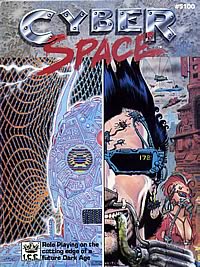
Call of Cthulhu is a horror fiction role-playing game based on H. P. Lovecraft's story of the same name and the associated Cthulhu Mythos. The game, often abbreviated as CoC, is published by Chaosium; it was first released in 1981 and is in its seventh edition, with licensed foreign language editions available as well. Its game system is based on Chaosium's Basic Role-Playing (BRP) with additions for the horror genre. These include special rules for sanity and luck.

The Generic Universal RolePlaying System, or GURPS, is a tabletop role-playing game system designed to allow for play in any game setting. It was created by Steve Jackson Games and first published in 1986 at a time when most such systems were story- or genre-specific.
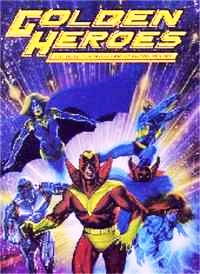
Golden Heroes is a British superhero role-playing game that was originally written and published on an amateur basis in 1981, and then republished in a more complete and professional form by Games Workshop in 1984.
Rolemaster is a tabletop role-playing game published by Iron Crown Enterprises since 1980.
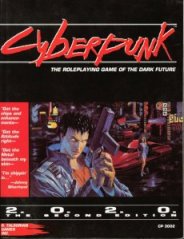
Cyberpunk is a tabletop role-playing game in the dystopian science fiction genre, written by Mike Pondsmith and first published by R. Talsorian Games in 1988. It is typically referred to by its second or fourth edition names, Cyberpunk 2020 and Cyberpunk Red, in order to distinguish it from the cyberpunk genre after which it is named.

Champions is a role-playing game published by Hero Games designed to simulate a superhero comic book world. It was originally created by George MacDonald and Steve Peterson in collaboration with Rob Bell, Bruce Harlick and Ray Greer. The latest edition of the game uses the sixth edition of the Hero System, as revised by Steve Long, and was written by Aaron Allston. It was released in early 2010.

Chill is an investigative and modern horror role-playing game originally published by Pacesetter Ltd in 1984 that captures the feel of 20th-century horror films.
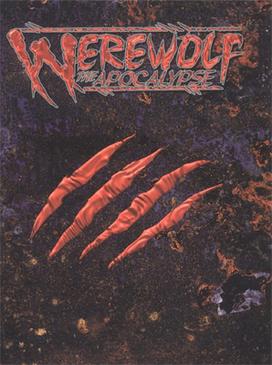
Werewolf: The Apocalypse is a role-playing game of the Classic World of Darkness game series by White Wolf Publishing. Other related products include the collectible card games named Rage and several novels. In the game, players take the role of werewolves known as "Garou". These werewolves are locked in a two-front war against both the spiritual desolation of urban civilization and supernatural forces of corruption that seek to bring the Apocalypse. Game supplements detail the other shape-shifters.

Castle Falkenstein is a steampunk-themed fantasy role-playing game (RPG) designed by Mike Pondsmith and originally published by R. Talsorian Games in 1994. The game is named for a legendary unbuilt castle in the Bavarian Alps. Players play the roles of gallant adventurers who take on quests of intrigue and derring-do in the spirit of Victorian adventures such as The Prisoner of Zenda.

GURPS Cyberpunk is a genre toolkit for cyberpunk-themed role-playing games set in a near-future dystopia, such as that envisioned by William Gibson in his influential novel Neuromancer. It was published in 1990 after a significant delay caused by the original draft being a primary piece of evidence in Steve Jackson Games, Inc. v. United States Secret Service.
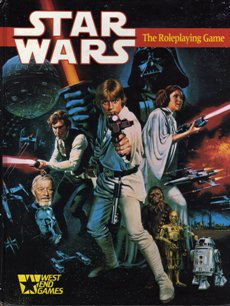
Star Wars: The Roleplaying Game is a role-playing game set in the Star Wars universe, written and published by West End Games (WEG) between 1987 and 1999. The game system was slightly modified and rereleased in 2004 as D6 Space, which used a generic space opera setting. An unrelated Star Wars RPG was published by Wizards of the Coast from 2000 to 2010. Since 2012 the official Star Wars role-playing game is another unrelated game, published by Fantasy Flight Games.

Dark Conspiracy is a near-future horror role-playing game (RPG) originally written by Lester W. Smith and published by Game Designers' Workshop (GDW) in 1991. Several newer editions have been published.

Ghostbusters is a comedy role-playing game published by West End Games (WEG) in 1986 that is based on the 1984 film Ghostbusters.

Dragon Warriors is a fantasy role playing game (RPG) system written by Dave Morris and Oliver Johnson and published by Corgi Books in 1985 and 1986. In 2009, it was re-collected in a new hardcover edition by Mongoose Publishing. This print run included the publication of several supplements to the Dragon Warrior's world "Legend". However, as of September 2010, this publication run had been discontinued but the books continue to remain available in PDF format.

Conspiracy X is a role-playing game (RPG) originally released by New Millennium Entertainment in 1996, and since revised and released by several publishers including Steve Jackson Games and Eden Studios, Inc. In all versions, the setting posits that aliens are insiduously taking over the world, reminiscent of The X-Files.
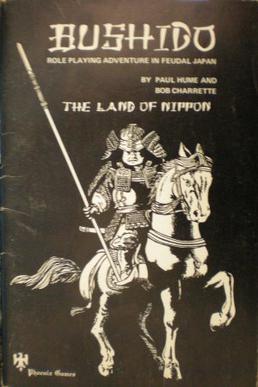
Bushido is a Samurai role-playing game set in Feudal Japan, originally designed by Robert N. Charrette and Paul R. Hume and published originally by Tyr Games, then Phoenix Games, and subsequently by Fantasy Games Unlimited. The setting for the game is a land called Nippon, and characters adventure in this heroic, mythic, and fantastic analogue of Japan's past.

Dream Park: The Roleplaying Game is a role-playing game published by R. Talsorian Games in 1992. It was designed by Mike Pondsmith and was based on the 1981 novel Dream Park, which is itself about a live-action role-playing game amusement park. The player characters take on the roles of the players in this holographic game, simultaneously playing both the character and the character's alternate persona.

Bubblegum Crisis is a near-future cyberpunk role-playing game published by R. Talsorian Games in 1996 that is based on the anime television series Bubblegum Crisis.

Street Samurai Catalog is a supplement published by FASA in 1989 for the near-future cyberpunk role-playing game Shadowrun.
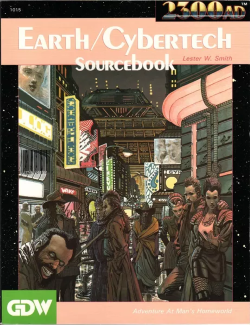
Earth/Cybertech Sourcebook is a supplement published by Game Designers' Workshop (GDW) in 1989 for the science-fiction role-playing game 2300 AD.
